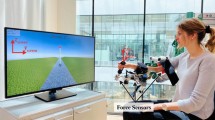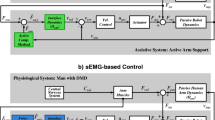Abstract
Progressive muscle weakness characteristic of Duchenne muscular dystrophy (DMD) results in loss of upper extremity active range of motion (AROM) despite residual muscle strength that is insufficient to overcome gravity. Admittance control is well suited for use by individuals with DMD as it allows for the utilization of residual muscle strength to intuitively control the motion of a powerful robot without requiring strength to overcome gravity and the friction and inertia of the robot. This study examined the feasibility of using the HapticMASTER, an admittance control motorized arm support, to increase the upper extremity AROM of individuals with DMD to a greater degree than that provided by the Armon Edero, a commercially available passive arm support. The results demonstrate that the HapticMASTER robot significantly increased the reachable surface area scores compared to the Armon Edero passive arm support (paired-samples t-test, t(5) = 3.984, p = 0.010, Cohen’s d = 1.6).
This research is funded by NJIT/Kessler Foundation Rehabilitation Engineering Research Center on Wearable Robots for Independent Living (NIDILRR-HHS 90RE5021) and Gustavus and Louise Pfeiffer Research Foundation.
Access provided by CONRICYT-eBooks. Download conference paper PDF
Similar content being viewed by others
Keywords
- Extremity Function
- Duchenne Muscular Dystrophy
- Admittance Control
- Assistive Device
- Neuromuscular Disease
These keywords were added by machine and not by the authors. This process is experimental and the keywords may be updated as the learning algorithm improves.
1 Introduction
Duchenne muscular dystrophy (DMD), a neuromuscular disease with a prevalence of 1 in 3500 male births, results in progressive muscle weakness causing loss of independence and imposing the demands of costly and intrusive assistive support and personal care for daily living tasks [1]. Upper extremity function begins to decline while ambulation is still possible and gradually progresses with time in a proximal to distal gradient, playing a prominent role in loss of independence [2]. Importantly, upper extremity functional limitations exist despite residual muscle strength because remaining muscle strength is not sufficient to lift the arms against gravity and therefore cannot be utilized by the individual [3].
Presently, there exist a number of commercially available assistive devices aimed at augmenting upper extremity functional deficit. These devices are not widely used by individuals with DMD and have been largely unsuccessful in delivering the independence they seek to provide. Passive orthoses, the most common of these commercially available assistive devices, increase AROM by reducing friction and balancing the user’s arm against gravity using a spring or rubber bands. Limitations of passive arm supports include imperfect gravity compensation and the requirement of sufficient muscle strength to overcome inertia, which render these devices ineffective for those in the later stages of functional loss [4].
Admittance control is an inherently safe and intuitive robotic control paradigm that maps the user’s applied force to the motion of a robot. The use of admittance control provides a means to balance the arm against gravity more precisely and to minimize friction and inertia, thereby decreasing the overall force required by the user to generate a movement compared to that required by a passive arm support [5]. The objective of this study is to investigate the degree of upper extremity AROM associated with use of an admittance control motorized arm support compared to that associated with the use of a passive arm support by individuals with DMD.
2 Materials and Methods
The upper extremity AROM of 6 individuals with DMD was evaluated while unsupported, while supported by the Armon Edero passive arm support, and while supported by the HapticMASTER admittance control robot. Figure 1 shows the Armon Edero arm support and the HapticMASTER robot. The maximum workspace of both arm supports is about 0.08 m3, with the HapticMASTER having a slightly smaller workspace compared to the Armon Edero. Inclusion criteria required individuals to be nonambulatory with limited upper extremity function (a Brooke scale score of 4 or greater). The reachable workspace protocol was administered for each of the arm support conditions and the reachable surface area scores were used as the primary outcome measure to evaluate AROM [6]. This study was approved by NJIT’s Institutional Review Board.
3 Results
Figure 2 shows an example of the reachable workspace evaluation output for one subject for unsupported movements, Armon Edero supported movements, and HapticMASTER supported movements. Figure 3 shows the mean reachable surface area scores for all 6 subjects for Armon Edero and HapticMASTER supported movements. The HapticMASTER robot significantly increased the reachable surface area scores compared to the Armon Edero passive arm support (paired-samples t-test, t(5) = 3.984, p = 0.010, Cohen’s d = 1.6). An a priori power analysis, conducted using G*Power 3.1 software, suggested that a sample size of n = 6 would be sufficient to obtain a minimum of 95 % power (α = 0.05, paired-samples t-test) to detect an effect, given an effect size of Cohen’s d = 1.6. Five out of 6 subjects showed increased vertical range of motion for HapticMASTER supported movements compared to Armon Edero supported movements. All subjects reported that less exertion was required to generate the reachable workspace evaluation movements while supported by the HapticMASTER robot compared to the Armon Edero passive arm support.
4 Discussion and Conclusion
The results of this study support the hypothesis that an admittance control arm support will provide individuals with DMD greater AROM than that provided by a passive arm support. Ongoing work involves the development of a wheelchair-mountable admittance control arm support that aims to increase independence in activities of daily living for individuals with DMD.
References
Jung, I.Y., Chae, J.H., Park, S.K., Kim, J.H., Kim, J.Y., Kim, S.J., Bang, M.S.: The correlation analysis of functional factors and age with duchenne muscular dystrophy. Ann. Rehabil. Med. 36, 22–32 (2012)
Bartels, B., Pangelila, R.F., Bergen, M.P., Cobben, N.A.M., Stam, H.J., Roebroeck, M.E.: Upper limb function in adults with duchenne muscular dystrophy. J. Rehabil. Med. 43, 770–775 (2011)
Mazzone, E.S., Vasco, G., Palermo, C., Bianco, F., Galluccio, C., Ricotti, V., Castronovo, A.D., DiMAuro, M.S., Pane, M., Mayhew, A., Mercuri, E.: A critical review of functional assessment tools for upper limbs in Duchenne muscular dystrophy. Dev. Med. Child Neurol. I 54, 879–885 (2012)
Rahman, R., Sample, W., Seliktar, R., Alexander, M., Scavina, M.: A body-powered functional upper limb orthosis. J. Rehabil. Res. Dev. 37(6) (2000)
Corrigan, M., Foulds, R.: Admittance control of the intelligent assistive robotic manipulator for individuals with duchenne muscular dystrophy: a proof-of-concept design. J. Rehabil. Rob. 3, 1–5 (2015)
Han, J.J., Kurillo, G., Abresch, R.T., Nicorici, A., Bajcsy, R.: Validity, reliability, and sensitivity of a 3D vision sensor-based upper extremity reachable workspace evaluation in neuromuscular diseases. PLOS Currents Muscular Dystrophy (2013)
Acknowledgments
The authors would like to acknowledge the developers of the reachable workspace evaluation software (G. Kurillo and J. Han, et al.).
Author information
Authors and Affiliations
Corresponding author
Editor information
Editors and Affiliations
Rights and permissions
Copyright information
© 2017 Springer International Publishing AG
About this paper
Cite this paper
Corrigan, M.C., Foulds, R.A. (2017). A Novel Approach to Increase Upper Extremity Active Range of Motion for Individuals with Duchenne Muscular Dystrophy Using Admittance Control: A Preliminary Study. In: González-Vargas, J., Ibáñez, J., Contreras-Vidal, J., van der Kooij, H., Pons, J. (eds) Wearable Robotics: Challenges and Trends. Biosystems & Biorobotics, vol 16. Springer, Cham. https://doi.org/10.1007/978-3-319-46532-6_57
Download citation
DOI: https://doi.org/10.1007/978-3-319-46532-6_57
Published:
Publisher Name: Springer, Cham
Print ISBN: 978-3-319-46531-9
Online ISBN: 978-3-319-46532-6
eBook Packages: EngineeringEngineering (R0)







